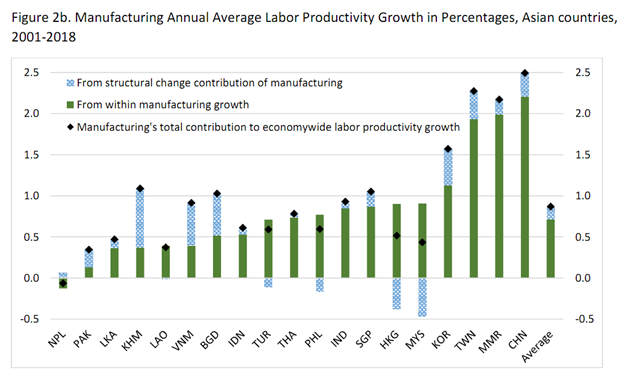
Caught up on this recent NBER WP on labor productivity growth and industrialization in Africa by McMillan and @AlbertZeufack
nber.org/papers/w29570
Offers a very useful overview of trends in manufacturing and structural transformation in SSA; worth quick 🧵 #EconTwitter
nber.org/papers/w29570
Offers a very useful overview of trends in manufacturing and structural transformation in SSA; worth quick 🧵 #EconTwitter
The paper uses a range of data sources, but the first is the Economic Transformation Database (ETD) including 18 SSA countries that allows for estimation of value added per worker across countries.
Estimates show that labor productivity growth has been 2.5% in SSA since 2000; this is mostly driven by shift of workers from ag to non-ag (i.e., structural transformation). Minimal contribution of within-sector productivity growth. 

At the country level, this graph shows that is essentially no correlation between productivity growth from structural change (blue) and within-sector productivity growth (green). In contrast, in industrializing Asian countries, the correlation is positive (right graph) 



Hence the puzzle: in Asia, the manufacturing sector becomes more productive, draws workers in from ag, amplifying the productivity effects; in SSA, this pattern is not observed
Why? Employment growth in SSA manufacturing dominated by small / informal firms (<100 workers) w/w low productivity. Larger firms appear to be relatively productive, but they are not growing. This graph shows ⬆️ in manufacturing emp in 8 countries w/formal emp relatively flat 

Paper also has a detailed case study comparing Ethiopia vs. Vietnam manu, highlighting key differences: much ⬇️ share of informal emp in Vietnam, much ⬆️ presence of foreign-owned firms, more “huge” firms (5,000+ emp): in 2017, >100 foreign firms of this size in Viet, 0 in Eth
Overall, very interesting and thought-provoking set of stylized facts to put structural transformation in SSA in context of patterns observed elsewhere (will also pitch recent paper w/@BilgeErten unpacking the role of export-driven growth in stimulating structural transformation
• • •
Missing some Tweet in this thread? You can try to
force a refresh




